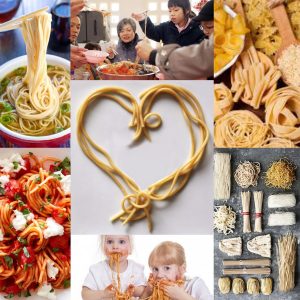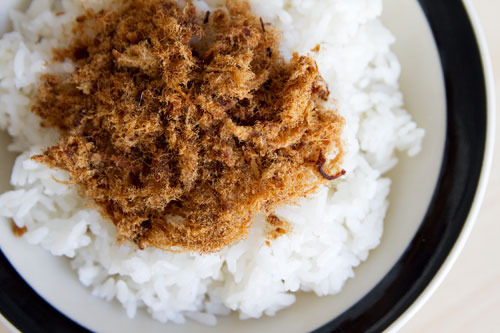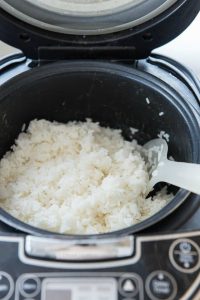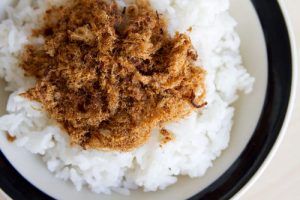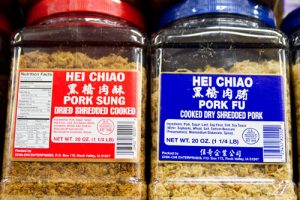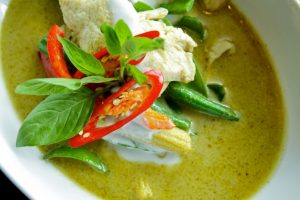by Abigail Chin
The noodle is a remarkable culture bearer for China and Italy because noodles reflect and illustrate the unique societal values and identities of both countries and their respective cultures in different ways. Noodles are made from simple ingredients, but the context in which they are produced and consumed within Italy and China imbue the noodle with great meaning and identity beyond the noodle’s simple categorization as a food product.
At the most basic level, the noodle performs the basic function of giving people affordable nutrition in both China and Italy. The base ingredients for noodles are some combination of flour, water, and/or eggs. As such, noodles contain protein, minerals, and carbohydrates, along with some minerals. Noodles in China are considered a staple food, as seen in “Bite of China: Staples Foods.” Noodles are a cereal food, and “cereal food is the main body of the traditional Chinese diet, the main source of energy for the human body, and also the most economical energy food” (Journal of Ethnic Foods, Ma and Zhang 212). Noodles have performed the all-important role of feeding millions of Chinese people for hundreds of years, and China is the largest consumer of noodles in present-day. Italy also relied on noodles as an economical staple food during different times in history. For example, in Let the Meatballs Rest we learn that around 1630, pasta was very popular in Sicily but less so in Naples, where it was still considered a luxury. During that time, Neapolitans suffered from terrible famine and poverty as a result of Spain’s poor governance. There was an extreme shortage of the former staple food meat, and the Neapolitans took advantage of the mechanical pasta maker and made macaroni their new, economical staple food in the place of meat. During that time, they were given the nickname “macaroni-eaters” because of their love of pasta, and in the 1800s Italy as a whole country took on that label (Montanari161-162). Noodles have played an essential part in providing wholesome nutrition to both China and Italy. The rise in popularity of macaroni in Naples is a great example of how different regions of Italy and China experience noodles in different ways, according to different regional characteristics and traditions.
In China, noodles are a staple food, but there are thousands of different noodles varieties throughout the different regions, provinces, and cities of China. Each region of China has its own signature noodle dishes with vastly different preparation methods and flavor combinations. China is a large country with so many different types of climates, so many food traditions remain popular in specific regions in part because their respective geographic environments and climates are conducive for growing and preparing certain foods. However, perhaps just as significant is the fact that certain food traditions arose in a specific region, and people in that particular region care to continue the tradition, or perhaps people in other regions do not have quite the same affinity for the tastes of other regions’ noodle dishes. It has been said Chinese are the most food-oriented people in the world, and food traditions are among the most important traditions that the Chinese people keep. This is illustrated beautifully by the way noodles are prepared and eaten throughout China.
Bamboo pole pressed noodles are a remarkable noodle dish that can only be found in southern China, while pulled noodles are a proud tradition of Northern China. Bamboo pole noodles are made in a small area of China that includes Canton and Hong Kong, while pulled noodles are made throughout a large area of Northern China. The art of making bamboo pole noodles is a strenuous and lengthy process that was invented one hundred years ago and has been passed down between each generation since then (Hsiang Ju Lin 309-311). The art of bamboo pole noodles requires patience, discipline, and precise attention to detail in order to achieve the proper texture and form of noodle. The process of making these noodles is detailed by Hsiang Ju Lin in “Slippery Noodles.” The dough is made by mixing duck eggs straight into wheat without water, and then pole operator must bounce and pivot on the bamboo pole for hours, folding the dough at certain intervals (309-311). A person who makes this type of noodle does so as his or her full-time job or career, because making these noodles properly requires a good amount of training and experience; it seems it is not the type of dish that a person can make at home on a whim. This noodle reflects the culture and discipline of the Southern Chinese people in the Canton and Hong Kong areas, because this process requires an hours-long commitment to excellence and quality in order to enjoy even one bowl of noodles. On an individual level, the bamboo pole operators’ dedication, strong work ethic, and craftsmanship is embodied in these noodles. The fact that these particular noodles have remained popular, and that the art has been passed down over a hundred years shows the value that Chinese culture places on the art of quality food.
On the other hand, pulled noodles give us a window into the cultural fabric of northern China. These noodles have a long history in northern China. While pulling the noodles, the “noodle-maker would give a riveting performance” (Hsiang Ju Lin 312). The fact that noodle-makers would put on a show in a street stall or in a restaurant reveals that they had a ready audience for their noodle-making. The Chinese are a food-oriented culture, and the ready audience for noodle-makers illustrates that Chinese people appreciated and continue to appreciate the artisanship and hard work that goes into making the noodles. This presents a stark contrast to American restaurants, where the chef and cooks most often remain behind the closed double doors of the kitchen, and never come out to show how food is made. In the USA, it seems that at nicer restaurants, it is essential that the process of cooking be hidden from the customer, with a distinct separation between front-end wait staff and back-end chefs and cooks. The emphasis and value are placed on the appearance and taste of the food when it lands on the dining table, but less so in the process behind it. The performance of noodle pullers illustrates that the Chinese, specifically the northern Chinese in this case, value every step of the noodle-making process, not just what ends up in their bowl on the table. Lanzhou pulled noodles are a different type of pulled noodles that were invented by Muslims who settled in the Xian and Lanzhou cities of northern China after they traveled in from the west on the Silk Road (Hsiang Ju Lin 313-314). This dish marries traditional Muslim beef soup with pulled noodles native to northern China. The soup was made from green parsley, red pepper oil, white noodles, radish, coriander, beef, spice blends, and a signature clear broth. The clear broth of this noodle dish is very different from the rich and heavy sauce that is often served with pulled noodles in northern China (314-315). This particular noodle dish is a great example of how other cultures could influence and contribute to the noodle culture in China. Lanzhou pulled noodles are a direct result of the Silk Road and how the Silk Road changed and influenced Chinese culture in the northern region.
In Italy, the noodle is a wonderful symbol of the entire Italian culture and more specific regional traditions. The earlier example of the Neapolitan development of a macaroni culture reveals an important aspect of Italian culture. When discussing Italian culture, it is important to recognize that each region of Italy has a distinct history. Each region was conquered, occupied, and liberated multiple times by different rulers and countries, and during different time periods. Some regions of Italy did not interact with other regions for hundreds of years at a time, so each region developed its own cultural identity and food culture. In addition, different regions of Italy have geographies that are suited to raising different kinds of crops and livestock, furthering the regional difference in cuisine. While pasta is now recognized as the signature food of Italy, each region has a very different history with pasta. In the Middle Ages, Sicily “was the region of Italy where industrialized dry pasta first took hold” (Montanari 161). Up to this point, Sicilians were known as “macaroni eaters” (161). However, around 1630 after pasta became an economical staple food in Naples following a period of famine, Neapolitans became known as “macaroni-eaters” (162). It wasn’t until the nineteenth century that the entire country of Italy was known as “macaroni-eaters” (162). Since this date coincides with the unification of Italy in 1861, I imagine that perhaps the unification enabled pasta in all its forms to travel and become widespread throughout the entire country, rather than stay confined within specific regions.
In addition, the example of cappelletti and tortellini further illustrates the different food traditions in the different regions of Italy. In the present-day region of Emilia-Romagna, the noodle dishes of cappelletti and tortellini are filled differently (Montanari 42). In Romagna, cappelletti are filled with cheese as a result of the sheep culture in the region. On the other hand, in Emilia tortellini are filled with meat as a result of the native pork culture 42). Both regions incorporate filled pasta dough into their regional cuisine, but the different fillings are a nod to their separate histories of occupation. While the landscape differences between Emilia and Romagna contributed to this difference, the fact that the Longobards occupied Emilia and the Byzantines ruled Romagna is a likely cause of different food traditions illustrated by these stuffed pasta dishes (42-43).
The noodle is an important cultural element of both Italian and Chinese societies and their respective cultures. Both the Chinese and Italians demonstrate their commitment to high quality food made with love and expert-level care through noodles. In the article “Noodles, Traditionally and Today”, we learn that there are thousands of noodle varieties in China (Zhang and Ma 210). These noodles are crafted with great care and hard work, such as with bamboo pole noodles and hand pulled noodles. Within Italy, there are hundreds of varieties of noodle shapes, from capellini to bucatini to the classic spaghetti. There must be thousands of unique pasta dish varieties after accounting for sauce varieties. The overwhelming variety of noodle shapes and forms indicates that both Chinese and Italian culture truly value the art and form of noodles. In Italian culture, “different shapes of pasta, although alike in substance, produce different effects on the taste buds” (Montanari10-11). There is an understanding in Italian culture that the form of food, such as pasta, will profoundly affect the taste or flavor of a dish. With this belief, the number of pasta shapes that have been created over the years clearly illustrates the Italian commitment to seeking excellent taste and flavor in food. In Chinese culture, the value of the balancing of the five flavors in conjunction with the hard work in making noodles illustrates the Chinese dedication to quality food.
Noodles play an important role in Italian culture because pasta is the food most associated with Italian food culture by both Italians themselves and by people throughout the world. The traditional pasta and tomato sauce is a great example of the signature of Italian cuisine. Italians, perhaps more than any other culture in the world, perfected the art of drawing from a variety of gastronomical cultures to create superb food. There is great debate over which part of the world first invented noodles, and we may never truly know if China or Italy or the Middle East created the first proper noodle. Regardless, the Italians took the noodle tradition and perfected the production and drying of noodles and pasta. Tomatoes and tomato sauce were brought to Italy from the Americas, and they are not native to Italy. However, because of the masterful Italian cooking techniques, pasta and tomato sauce will forever be associated with Italy’s cultural identity. Pasta is the perfect “metaphor for the unity and variety of Italian alimentary styles” (Montanari 160). The Italians’ ability to draw from different gastronomical cultures is an important part of Italian food culture, and the noodle personifies this ability more than any other food.
Noodles have an incredibly important position in Chinese food culture because of the Chinese are an incredibly food-oriented culture. Food is interwoven into all of the significant Chinese customs, rituals, life events, and holidays. Noodles in China are especially imbued with customs and meaning. For example, many noodle dishes have other names that reflect their place in Chinese culture rather than the food in the dish Qishan minced noodles are also known as “sister-in-law noodles” because it is said that a poor student was able to pass his civil service exam only because of the great noodles his sister-in-law prepared for him. Later, many people tried to cook the same noodle dish to seek success for their sons in their exam. So, the noodles also took on another epithet of “ashamed son noodles,” in reference to parents’ shame when the same noodle dish did not lead to their son’s success. The naming of noodle dishes shows that many noodles dishes are linked with other aspects of life, and the food is always connected to other aspects of life. There are many other noodle dishes that are forever linked with certain traditions or customs in Chinese culture. For example, longevity noodles or long-life noodles, are served at birthday parties. In “Bite of China: Staples Foods”, we see that there is a beautiful noodle tradition that is performed at a 70th birthday celebration in one village in China. Since long noodles are associated with a long life, every member of a village is served a bowl of noodles upon arriving at a birthday party. Each person picks the longest noodle out of his or her bowl, and places it in the bowl of the man who is celebrating his birthday. The birthday celebration can only be complete after the man eats the bowl of the longest noodles. Here, the noodles symbolize the love and good wishes from every member of the community to this man. It is clear that noodles in Chinese culture are much more than the ingredients, they are a special food that represents love and can guide one through both big and small life events.
Both Italian and Chinese cultures emphasize the importance of eating meals with loved ones. In China, it is incredibly important to eat food with family. In Italy, a big part of the Mediterranean diet tradition is eating with others, whether that be friends or family. The amount of hard work, care, and attention to detail that goes into selecting, preparing, and eating noodles is more than the sum of its parts: it is love. There is love that goes into preparing noodles well in both Italian and Chinese culture. In the story “Crossing the Bridge”, a family chef labored over many noodle dishes and experimented with many techniques and styles of cooking until he found the perfect technique to keep noodles warm for the beloved son in the family (Durack 182-183). In the “Art of the Feast”, we see the time and care the women in an Italian family put into shaping hundreds of little tortellini by hand. In the same episode, we see two men go around to several different shops over the course of a whole day to collect the perfect ingredients for just one noodle dinner, as is common in Italian culture. Making noodles with pride and care for others is an act of love. In “A Bite of China: Staple Foods”, a cameraman named Bih-Bo lives in Beijing with his wife, while his two daughters, parents, and parents-in-law live far away in the countryside. He is only able to see his parents and twin daughters once a year, at the Spring Festival celebration. He mentions that his favorite dish is his mother’s braised noodles. He explains that the traditional noodles and jaozi that his family makes together during this time will remain a “seed planted in [his children’s] soul” that they can always remember and think of as a happy memory with family. All of these examples stand in stark contrast to the American culture of fast food, where speed and hunger gratification are valued highest, and there is much less emphasis on the source of ingredients or what it actually takes to bring wonderful food to the table.
What is the noodle/what are noodles?
The noodle is a combination of flour and some liquid that can be shaped into hundreds of shapes, with varying thickness and hundreds of textures, by a variety of methods such as pulling, pressing, and casting with molds. The noodle provides a healthy form of nutrition and sustenance for all people across the world’s many cultures. It is a nutritious, wholesome food that comes from a global gastronomic tradition of quality, care, wholesome nutrition, and love. Throughout human creativity and hard work, society has created thousands of different noodle dishes.
Noodles have fed people for hundreds of years, during times of prosperity and times of desperation. They can convey nonverbal messages such as well-wishes, good luck, celebration, and love. When the noodle is prepared with love, it can bond families, build friendships, and strengthen communities.
